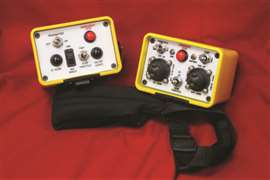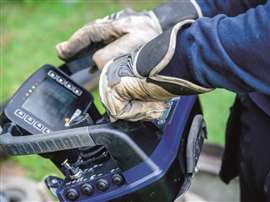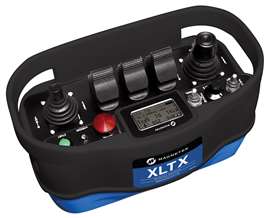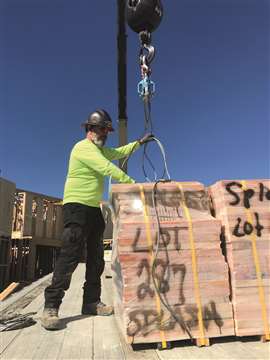Rounding up the latest remote control products
22 June 2023
Remote control technology is being applied to myriad lifting and rigging applications.
In a world driven by the “latest and greatest” mindset, especially when it comes to technology, it’s safe to say the demand for wireless remote controls is high and getting higher. However, like many other pieces of machinery in the industry, getting the parts needed from suppliers has caused a backlog. But as the technology continues to advance, the heightened use of remote controls can be attributed to increased safety, ease of operation and potentially, an increase in productivity. Today, remote controls can be seen utilized for cranes, SPMTs and other rigging and specialized transport machines.
Microtronics, an Iola, KS-based manufacturer of industrial wireless controls, observed that advancements to cranes and related rigging gear are occuring regularly, and customers are asking for enhancements to their wireless remotes, as well.
 Since 1991, Microtronics has provided industrial wireless controls for industries that manufacture equipment such as concrete pumps, tub grinders, cranes, stump grinders, slope mowers, excavators, equipment trailers, track machines, fire trucks and more.
Since 1991, Microtronics has provided industrial wireless controls for industries that manufacture equipment such as concrete pumps, tub grinders, cranes, stump grinders, slope mowers, excavators, equipment trailers, track machines, fire trucks and more.
“Technology will continue to be the driving force in our industry for safety and productivity,” said Steve Cunningham, director of sales and marketing, Microtronics.
Keep reading to check out the latest remote-control products on the market.
Customized solutions
For nearly 40 years, Sweden-based Scanreco has engineered and manufactured professional radio remote controls for cranes, vehicles and mobile hydraulic equipment. Scanreco’s flexible new G6 platform enables smaller local/regional OEMs to develop customized remote-control solutions without having to spend large amounts of capital on R&D and product development.
The G6 Platform allows smaller OEMs to intuitively design remote control solutions that are based on real-life field conditions and operator experience, the company said. Scanreco’s G6 Platform offers flexibility as to where and how to place any lever, joystick, button or switch without compromising on functional safety. Scanreco’s mission is to contribute with a more intuitive operator’s interface that increases safety and productivity, while reducing training time and learning curves through intuitive placement of controls that best benefit the operator.
 Scanreco’s G6 Platform offers flexibility for where and how to place any lever, joystick, button or switch without compromising functional safety.
Scanreco’s G6 Platform offers flexibility for where and how to place any lever, joystick, button or switch without compromising functional safety.
Furthermore, G6 solutions can be designed to provide accurate machine feedback via color screens, LCD screens, or simple LED panels. Scanreco color screen programming capabilities are endless. Screens can be programmed to fully provide operators with real-time machine conditions. Scanreco’s transmitter screens can make any operator a smart operator, the company said.
Additionally, the G6 Platform integrates Scanreco’s innovative SISP technology (Scanreco Integrated Safety Platform). SISP is a first-of-its-kind modular safety solution, developed by Scanreco and approved by a third-party (Rise Research Institutes of Sweden), in accordance with the IEC 61508 (SIL3) and ISO 13849-1 (PLe) safety standards.
SISP consists of four microprocessors working simultaneously; two in the transmitter and two in the receiver. Residing on Scanreco’s robust proprietary radio protocol in which all data is sent multiple times on different frequencies, SISP ensures safe and secure data transfer and machine functionality.
Maximizing performance
Columbus McKinnon’s latest solution, the Magnetek brand XLTX bellybox transmitter with new RF module, features improved functionality that allows radio remote control systems to operate on a wider range of licensed and unlicensed frequencies. These radio systems are more robust and reliable, plus they ensure there are fewer dropouts in facilities that may already have heavily congested frequency bands. When wireless devices are not competing with other wireless devices on the same frequency, their performance is maximized. When radio control performance is maximized, facilities gain the full benefit of radio controls, including increased safety, improved efficiency and reduced downtime.
 The updated Magnetek XLTX radio remote control also includes a high-powered option for licensed frequencies that enables the operation of radio systems at distances farther away from equipment when needed.
The updated Magnetek XLTX radio remote control also includes a high-powered option for licensed frequencies that enables the operation of radio systems at distances farther away from equipment when needed.
The range of frequencies offered by the XLX radio remote control also enables easy modernization of new or existing installations. Equipment that is controlled on one of the newly available frequencies now communicates more data back to the transmitter via the same RF connection. Passing more data across the two-way feedback increases the intelligence of the XLTX system, ensuring useful information is transmitted from the equipment back to the operator. The data returning to the transmitter, which could include weight feedback, faults, alarms and more, can be provided to an operator via an audible signal, visible light or text on an LCD screen. Two-way feedback not only improves operational productivity and safety, but also provides additional diagnostic information for faster troubleshooting when maintenance is needed, the company said.
Quick release hook
The LudwigHook, distributed throughout North America by OTH Pioneer Rigging, is a quick release below-the-hook lifting device designed to speed up the lifting process and reduce risk to workers by keeping them from manually unhooking rigging.
 The LudwigHook, distributed throughout North America by OTH Pioneer Rigging, is a quick release below the hook lifting device that utilizes a radio remote control to trigger the opening mechanism.
The LudwigHook, distributed throughout North America by OTH Pioneer Rigging, is a quick release below the hook lifting device that utilizes a radio remote control to trigger the opening mechanism.
The radio remote control is used to trigger the opening mechanism and has a range of 200 feet. When the load is set down, the opening mechanism switches on, allowing the user to release the hook. The opening mechanism of the hook switches off when lifting over 55 pounds, ensuring that the load cannot be dropped during a lift. With a long-lasting battery life, one hook is capable of making more than 500 lifts before needing to be charged.
When using a traditional method, it takes up to five minutes to release rigging from the load and make it available for the next lift. This step alone costs contractors between $30,000 to $100,000 for each crew in one year, the company said.
“On average, crews that have implemented LudwigHooks are eliminating 150 hours each year simply by cutting the time it takes to release the load,” said Oliver Gleize, president of OTH Pioneer Rigging. “Based on customer feedback, this translates to $1,900 per week and users typically see a return on the investment in 10 weeks.”
STAY CONNECTED


Receive the information you need when you need it through our world-leading magazines, newsletters and daily briefings.




